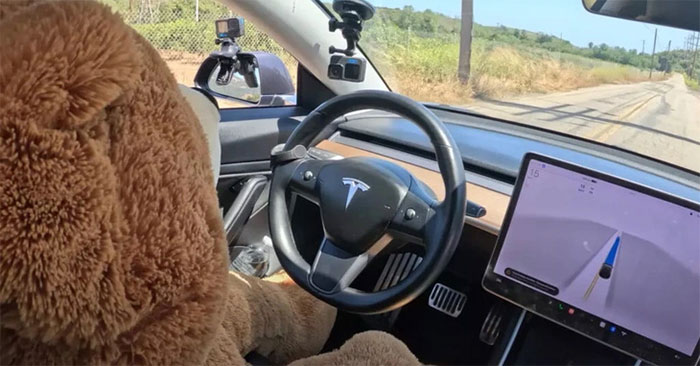
A viral video on Twitter reveals that even placing a teddy bear on the driver’s seat can deceive the driver monitoring system of a Tesla electric car. This advanced system is designed to keep the driver attentive and vigilant to potential hazards while the vehicle is in motion.

To carry out this experiment, Dan O’Ward, who is associated with the Dawn Project channel, joined forces with YouTuber AI Addict. Their intention was to deceive the system by placing a lightweight object on the steering wheel of the electric car, giving the impression that the driver’s hand was resting on it. They proceeded to take turns placing various items such as teddy bears, oversized beer bottles, balloons, and more on the driver’s seat to imitate a driver. Afterwards, they activated the self-driving mode to observe the outcome.
Initially, there was a large teddy bear occupying the driver’s seat of the electric car. Surprisingly, the monitoring system failed to provide any warnings and the car proceeded to operate without any issues. In order to assess the emergency braking system’s functionality, the test team strategically positioned a small doll in the car’s path. However, due to the system’s delayed recognition of the doll as a “person,” the car was unable to apply the brakes in a timely manner, resulting in a collision.
The second test was a complete outlier, like finding a unicorn, and the driver monitoring system proved to be utterly ineffective. Consequently, the doll was either stabbed or, even worse, it failed to come to a stop.
In spite of there being no heavy objects on the driver’s seat during the last test, the car managed to run. It collided with a doll across the street before coming to a brief halt, but ultimately decided to continue moving.
In a separate test conducted by YouTuber Whole Mars Catalog, the driver monitoring system proved to be effective. Throughout the test, the driver consistently directed their focus towards their phone, prompting the system to issue warnings, reminding them to concentrate on the road. As the driver disregarded these warnings on four occasions, the self-driving system was ultimately deactivated.
It remains unclear whether the car utilized by Dawn Project and AI Addict in their testing had experienced an update error that resulted in a malfunction of the driver monitoring system. However, it is evident that this system is currently lacking stability, indicating that both self-driving technology and driver monitoring have a significant amount of progress to make.


